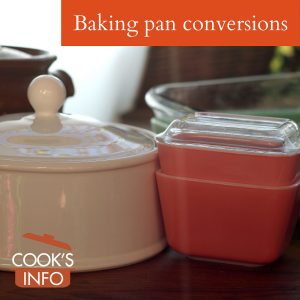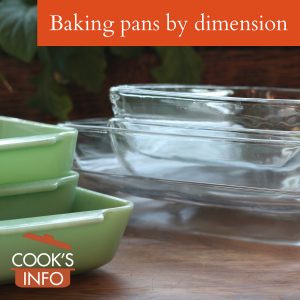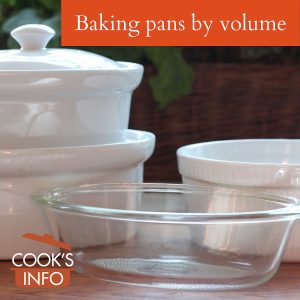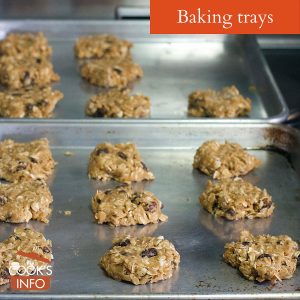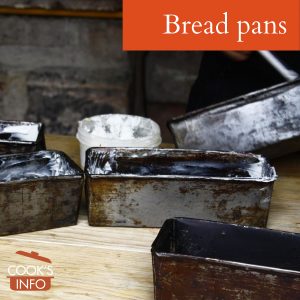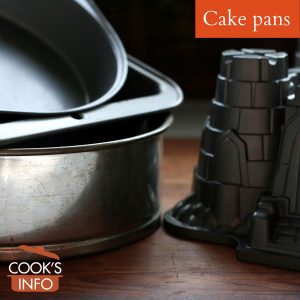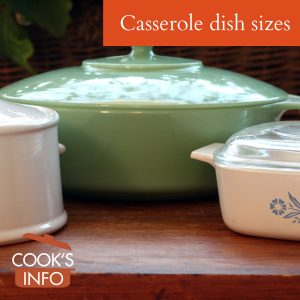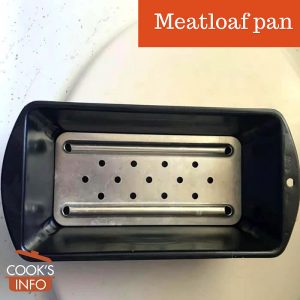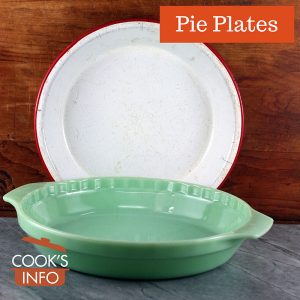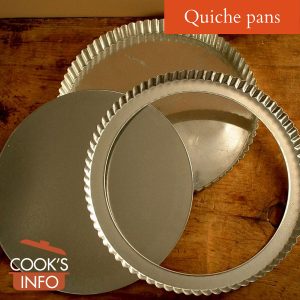
Baking pans. © CooksInfo / 2020
The term “baking pans” is a very broad category. It can be any shape of pan, made of any material, designed to hold any type of food stuff, sweet or savoury, solid or liquid. The common factor they will have is that they are dry-heat safe for baking food in an oven.
Some are designed only for baking in. Some are “fancy enough” that they can be used for serving out of as well.
Some will have handles, some will not; some will have rims or rolled edges, some not.
Some food writers limit the definition of baking pans to mean just “cookie sheets with edges.”
Most cooks find that they need at least a few different types of baking pans.
If an item is called a “baking dish”, it tends to be made out of ceramic or glass, and have mid-height walls. “Generally speaking, baking dishes are used for lower temperatures and slower cooking times.” [1] Baking dishes & roasting trays. In: Healthy Cooking Made Easy with BBC Good Food. BBC Good Food. Micro course. Step 4.9. Accessed August 2021 at https://www.futurelearn.com/courses/healthy-cooking-made-easy-with-bbc-good-food/2/steps/1224913
History
In her book, Vintage Kitchenalia, Emma Kay notes the evolution of the usage “baking pan” into “baking tin”:
“The phrase bread tin, or loaf tin, was not commonly in use until the mid-1800s, although Elizabeth David notes that Eliza Rundell’s 1807 edition of ‘A New System of Domestic Cookery’ is one of the earliest references to be found… The phrase ‘patty pan’ comes from the French word paté, meaning paste, plus pan. Early ones were made from tinned steel and came in a variety of shapes and sizes and were used to make tartlets and small cakes… Once tin had become the popular metal of choice in manufacturing, the word pan began to disappear, to be replaced with tin. It was certainly a word in common use by the 1920s. According to a story that appeared in the Dundee Evening Telegraph of 1921, a little German girl was travelling by train alone in a compartment and having realised the train had gone past her stop, opened the carriage door and held out a large ‘cake tin’ she had been carrying to break her fall as the train pulled away at some twenty miles an hour. She survived, despite serious injuries and shock.
One of the most prolific makers of baking tins during the early twentieth century, including the basic flan, tart, sponge finger and early sandwich varieties, was H.J. Green & Co. Ltd., based in Brighton and established around 1910; it traded until 1948.” — Kay, Emma. Vintage Kitchenalia. Gloucestershire, England: Amberley Publishing. 2017. Google Ebook edition.
Types of baking pans
Baking Pan Conversions
Baking Pans by Dimension
Baking Pans by Volume
Baking Trays
Bread Pans
Cake Pans
Casserole dish sizes
Meatloaf Pans
Pie Plates
Quiche Pans
References
| ↑1 | Baking dishes & roasting trays. In: Healthy Cooking Made Easy with BBC Good Food. BBC Good Food. Micro course. Step 4.9. Accessed August 2021 at https://www.futurelearn.com/courses/healthy-cooking-made-easy-with-bbc-good-food/2/steps/1224913 |
|---|


